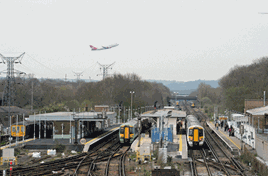The initial delivery is just one train. The second will not follow until October, but gradually the rate will increase to one new train a week. In Germany, the first 20 trains are effectively completed, all of them in the longest 12-car configuration.
Curtis explains: “From our perspective there are three stages of acceptance. First the network has to be able to accept the trains without power, so they can be delivered from the Channel Tunnel to Three Bridges depot. So we’ve had to make sure the route there (and later to Hornsey depot) is gauge cleared for the new trains. Some of that has involved changing the alignment of curves in and around tunnels.
“We don’t just do that on the delivery or test routes, of course. We do that on potential diversionary routes as well. Bedford to Brighton sounds very straightforward, and north of St Pancras it is. But south of Tulse Hill there are various routes the train could be asked to go - we’ve had to clear via Crystal Palace, Streatham and Selhurst, and from Haywards Heath via Lewes to Brighton.
“We compare our database with the profile of the train - we call it the kinematic envelope, the shape of the train when it is moving. In a small number of cases it meant we had to do some work - realigning track, lopping the end off a platform coping stone, or taking a brick out of a bridge parapet.”
Upgrades to the power supply have also been needed, with the new Siemens trains longer than many of the services they will replace.
“Next we go through the process of running the train under its own power,” explains Curtis.
“That requires a lot of work. It needs electrical compatibility - we have to make sure it will not interfere with the signalling or with existing power networks. And the driver has to see all the signals.
“This is a fixed-formation 12-car train. At some point it will break down. Then we will have to push it out of the way with another train. And that will potentially be another 12-car train doing the pushing. So we are talking about a 24-car train. That’s 500 metres long. There really are not many places on the route where we can deal with a 24-car train.”
Curtis adds that the third stage is to run trains with passengers onboard.
“For that we’ve had a fair bit of work to do at stations. The stations in the core - London Bridge to St Pancras - will have level access to two of the coaches for mobility-impaired passengers. For wheelchairs, there will be humps on the platforms where two of the coaches will stop.
“Today a wheelchair passenger can board at any convenient place on the train. With the Class 700s, they will go on two particular coaches. That means we have to change the stopping positions at some stations - moving the 12-car and eight-car stop boards in many cases, and then making sure the driver can still see the signals clearly.















Login to comment
Comments
No comments have been made yet.